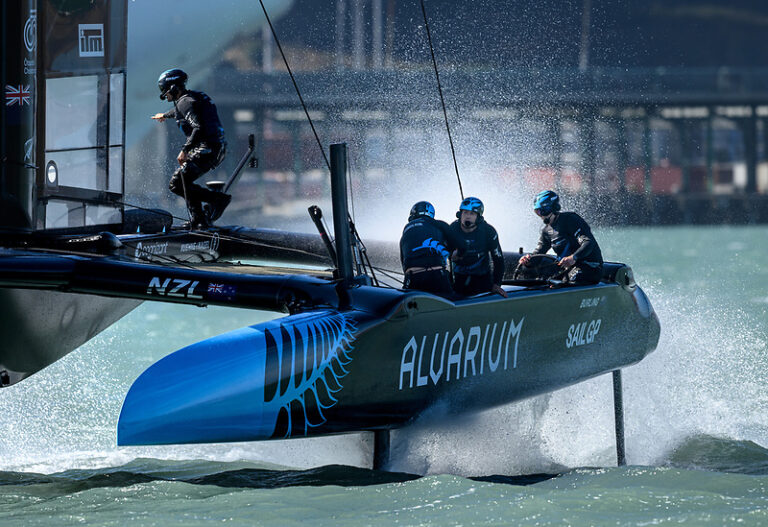
Doyle Rounding
Dodging traffic, staying at top speed, and executing the mark-rounding maneuvers after an exhausting upwind beat makes the top third of any weather leg one of the most intense parts of the racecourse. It’s where boatlengths can be gained or lost, especially during the weather-mark rounding. But setting the spinnaker and turning onto the run should be more fun than work-if you’re prepared. Let’s look at Vanguard Team Rider Mike Menninger, who in February qualified for the ISAF Youth Worlds, and his stand-in crew, coach Bryan Pryor, as they show us how it’s done in a 420.
1. To keep the boat flat when Bryan comes off the trapeze, Mike hikes extra hard. As Bryan comes inboard he reaches down to get the pole, trying to keep his weight to windward as much as possible.
2. Notice how flat the boat is with Bryan’s weight at the tank versus the previous photo where he’s standing and leaning to windward. Bryan attaches the pole to the guy first and then to topping lift. Mike and Bryan recognize that they’re slightly overstood so they ease the jib early. Mike eases the mainsail to help the boat turn downwind. The less the skipper steers with the tiller during this or any maneuver, the better.
**3****. **Bryan eases the jib before getting the pole on the mast. This allows the boat to sail at full speed while turning rather than slowing down in the turn because the sails are over trimmed. Be careful not to ease the jib too much; the head of the spinnaker might get caught up in the jib sheet or jib when it comes out of its bag. Mike makes sure the boat is flat, or heeled slightly to windward, for the downwind turn.
4. Bryan waits to connect the pole to the mast so he can push the pole out to weather while Mike pulls up thehalyard. This combination allows the spinnaker to come out and fill immediately without needing too many adjustments. As Mike reaches for the halyard, he’s hand steering, which is important. The more he hand steers, the more control he has during the maneuver.
5. Notice the spinnaker halyard is not in the guy hook or any other retaining device, which allows it to run free to the top of the mast. Some sailors use a bit of tape or batten, either of which will break free when the skipper pulls on the halyard tail. This keeps the halyard under control on the windward leg. Mike transitions to using his legs in order to steer. Doing so frees his hands so he can manage the spinnaker sheets and halyard.
6. In heavier winds it’s important for mike to keep the tiller in his hand. Cleat the guy and let the crew handle the spin sheets. As the halyard goes up, the pole goes out in unison. The pole tensions the guy when Bryan pushes it outboard, and this action helps force the windward clue out of the spinnaker bag. As soon as Bryan puts the pole on the mast the spinnaker will be full and although the weather mark is now out of the picture, it is only just out of the picture.
7. At this point, mike must fly the spinnaker, cleat the halyard and steer the boat. A goal, as you get better at this, is to hold the tiller through as much of the maneuver as possible rather than putting it between your legs. Once the pole is on the mast, Bryan can check to make sure the guy is still cleated on thewindward side. He then moves his weight to windward while Mike moves to leeward and forward at the same time. Once to leeward Mike switches back to hand steering.
8. In windier conditions the skipper may not be able to move to leeward and will have to stay in the center of the boat while crew goes to the trapeze. Once the crew is on the wire the skipper would go to the leeward tank where he or she can reach the jib sheet, centerboard, vang, and mainsheet to make the proper adjustments as they sail down the leg. As it gets even windier, these settings must be taken care of well before the set.









